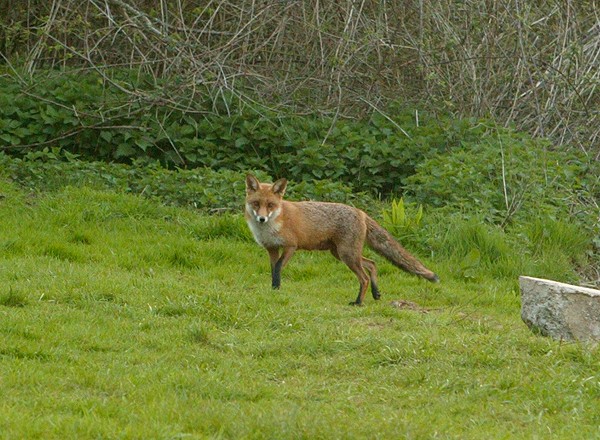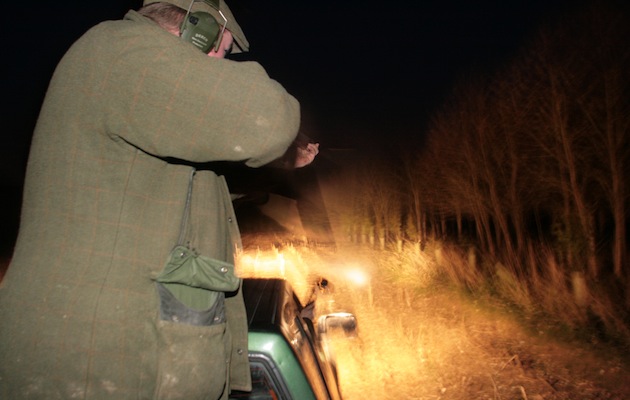How to control foxes when they’ve become lamp shy
Liam Bell outlines some options

Springtime is fox time
Controlling foxes by lamping has been revolutionary. You only have to look at the numbers. More foxes are accounted for by lamping than are killed by all the other methods of fox control put together. Lamping foxes is straightforward: you see the fox, get into position, and take the shot.

Lamping foxes
The downside to lamping foxes
On the minus side though if you miss a fox when you’re lamping you almost certainly won’t get a second chance. Foxes are wary and become lamp-shy almost immediately, running off the second the beam touches them.
So you’ll have to try something else for controlling foxes that have learned to become more wily.

Snares don’t rely on attracting the fox in some way; they intercept an animal going about its business
Snaring foxes
If I have a fox that’s interested in my pheasant pens or hunting partridges this is the first thing I do. Snares are easy to set and fairly cheap to buy. You don’t need many but you do need to have fieldcraft. A lamp-shy fox will hunt the same patch of ground most nights so if you can find a decent run leading into one of his favourite fields you’re going to be more successful. Find a spot where the run goes through a patch of rough grass or light cover and set the snare where the run is at its narrowest – this will help to guide the fox into the noose.
If the fox gets out of the noose re-set the snare 30 or so yards away but on the same run. There’s every chance you’ll catch him again because a fox that has been in a snare doesn’t actually know what it was caught by, so it associates being caught with where it happened and not with the snare itself.
Fox drives
This is how it used to be done in the days before lamping. Fox drives are useful and good for dealing with lamp-shy foxes if you know where they are lying up. Avoid big gangs of beaters and Guns as you’ll just alert the fox – I prefer to have just one or two lads who know the ground drive a patch out towards me and possibly one other Gun.
Older, wiser foxes (which are usually the ones that are lamp-shy) don’t take much moving and generally follow the same line out of a wood or patch of cover. This makes them easier to intercept once you’ve driven a patch once or twice and know the way they’ll run. When a wood is being driven towards me I’ll stand inside the wood on a run and make sure I’m up against a tree or have something behind me to break up my outline. Then I wait until the fox is really close before shooting it with a heavy load. If it moves once it’s been knocked over I immediately give it another barrel to be on the safe side.

If you can sit still and have patience, foxing from a high seat can be very effective
High seats
If a wary fox is in the right place a high seat can be very effective. I think the small portable ones that can be carried or tied to a quad bike are good. The advantages to sitting on a high seat over sitting or standing on the ground are twofold: firstly, scent is carried off over the head of the fox we’re waiting for, and secondly they offer a better field of view.
A relatively low seat, where you’re sitting just 10ft off the ground, is high enough to carry your scent off and for you to be able to see into a plantation or field that would otherwise be screened off by cover if you were standing or prone. A high seat is also safer if you’re using a rifle as the bullets will be driven into the ground. Set one up on the edge of the field or patch of cover where you’re seeing the fox at night, and sit in it until it’s too dark to see through the scope before coming home. It is often in the last few minutes of daylight that they make an appearance.

Working terriers to ground is legal in order to control foxes for the protection of gamebirds. If you have a fox that won’t flush, terriers could be a solution
Controlling foxes with terriers
If you think the fox has gone to ground get someone with a terrier to check out all the likely looking holes, drains and hollow trees and see if the dog can find it and get it to bolt either into a net or to a waiting Gun. It’s also worth looking up the older trees, especially ones with a slight lean to them and the ones covered with ivy, and running the terrier through bales, even if they’re close to the farmyard itself as they are another favourite place for foxes to lay up out of the wind. Working terriers to ground controlling foxes for the protection of gamebirds is legal and a great way to catch up with a wily Charlie who knows the meaning of the lamp.

Lamping is effective, but make sure you don’t make the fox lamp-shy
Night sights
Everyone I know with a night sight swears by it. They’re useful for shooting lamp-shy foxes because Charlie never knows you’re there. Those that have one tend to use it in one of two ways — as a replacement for a lamp where the fields are scanned for foxes, and any seen are either called in or stalked where they are, or for spotting foxes coming towards them when they’re sitting waiting by a pen or on the edge of a wood.
How to call a fox
HOW TO SQUEAK A FOX: Here the Nataional Gamekeepers Organisation tell you how to call in a fox.
How to use snares for fox control
How to use snares for fox control correctly and legally
What is the best rifle for shooting foxes?
What’s the best rifle for foxing? How should you choose?
One friend of mine sits out near his birds with his terrier and waits for the dog to get excited (which it does when it smells or sees a fox) before looking through the sight and shooting the fox as it prowls around the outside of the pen. Like many of the lads, he has his night sight mounted on a .22 rimfire because he is shooting so close to pens and doesn’t want to disturb the birds or push them off roost with the report from a centrefire rifle. A .22 would be on the small side for shooting foxes under normal circumstances but the ones he shoots with the night sight don’t know he’s there — they’re shot at close range and he has plenty of time to put his shot in the right place.











